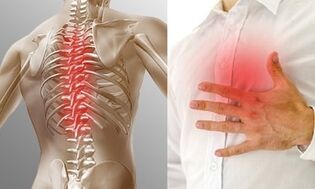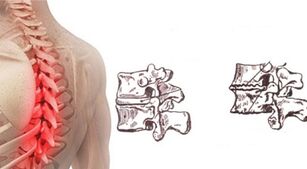Thoracic osteochondrosis is rare in clinical practice. It was previously diagnosed mostly in the elderly, but is now often detected in patients under 35 years of age. The pathology develops more often in women than in men. This degenerative-dystrophic disease is difficult to diagnose, because serious symptoms appear only in the later stages.
In addition, the symptoms of this disorder are easily confused with signs of lung and heart damage. This disease cannot be left without treatment, because it can cause curvature of the spine, the development of permanent pain syndrome and other complications that can negatively affect the quality of human life.
What is thoracic osteochondrosis?

In the international classification of diseases, this pathological condition has an ICD-10 code - M42. Thoracic osteochondrosis is much rarer than cervical or sacral. This is no accident. Due to the presence of a rigid rib in this part of the body, this part of the spine is physiologically less mobile.
The thoracic region contains more vertebrae than the cervical and lumbar, but in this part of the spine the discs are thinner. These anatomical features contribute to the reduction of the mobility of this part of the spine, so it is less prone to injuries.
However, when exposed to a number of adverse factors, osteochondrosis can develop. Initially, there are signs of damage to one disc, but in the future, other elements may be included in the pathological process. As the disease progresses, the bone elements are damaged, as well as the ligaments and muscles that support the spine.
Degenerative-dystrophic processes in the thoracic region grow more slowly. It is not uncommon for years before the fibrous rings of damaged discs are so destroyed that protrusions and hernias appear.
Severe clinical manifestations occur after a critical reduction in disc height and root jamming. This can lead not only to dorsag, ie short-term attacks of pain in the thoracic region, but also to a violation of the innervation of internal organs. It is much more difficult to treat pinched nerve roots that extend in this area.
Reasons for development
In most cases, spine problems do not occur suddenly. A disease like osteochondrosis is no exception. This pathology, which affects the intervertebral discs, is the result of long-term degenerative-dystrophic processes. In most cases, it is impossible to determine exactly what triggered the development of the disorder. Factors that can cause osteochondrosis of the thoracic spine include:

- congenital or acquired spinal deformities;
- overweight;
- spinal overload during pregnancy;
- infectious diseases;
- hypothermia;
- metabolic disorders;
- hormonal disorders;
- chronic stress;
- bad habits;
- connective tissue disease;
- dysplastic changes;
- posture disorders;
- unhealthy diet;
- injuries.
Detraining negatively affects the condition of the spine. People who lead an inactive lifestyle are more likely to suffer from osteochondrosis in the chest. In addition, the occurrence of these disorders contributes to age-related changes and slowing of metabolism, which are observed in patients older than 55 years.
Genetic predisposition can be a factor that can cause the development of pathology. The genes that create the conditions for the occurrence of osteochondrosis in the chest have not yet been identified, but in people with a family history of cases of this disease is more often diagnosed.
Symptoms and signs
The clinic of this pathological condition depends on the degree of neglect of the process, the level at which the lesion of the intervertebral disc occurred and the age of the patient. There are no specific signs in the early stages of development, but general symptoms may occur periodically. Often, in the initial stages of development, the disease manifests itself only with the beginning of cold weather or after physical exertion. The initial manifestations of the development of osteochondrosis of the thoracic region include:
- rapid fatigue;
- back pain and pressure;
- muscle cramps;
- cold extremities.
As the disease progresses, the patient's condition worsens. Painful chest pains appear. They especially often occur in the background of a long stay in one position or sudden movements. In addition, when lifting weights, severe pain syndrome may occur. Turning the torso can cause increased pain. The presence of osteochondrosis is also indicated by the appearance of dull pain in the area of the shoulder blades.
Often osteochondrosis of the chest is accompanied by the appearance of abnormal bending. In severe cases, the patient may develop a hump. In addition, this disease can cause pain during deep inhalations and exhalations.
When the nerve roots are tightened, numbness of the upper limbs and skin of the upper body is often felt. Due to the violation of innervation and blood circulation, a feeling of goosebumps appears on the skin. Legs and hands are always cold. Limb tenderness may be present. In advanced cases, this disease can lead to the appearance of symptoms of damage to other organs as a result of violation of their innervation. The following may occur in the final stages of the process:

- intercostal neuralgia;
- stool disorders;
- bloating; heartburn and nausea;
- itching and burning in the feet;
- violations of the reproductive system;
- asthma attacks.
As the pathology progresses, a person's ability to work declines. Physical activity is kept to a minimum. In the future, this disorder may create preconditions for the development of severe complications. The risk of pathological fractures increases. The curvature of the spine leads to compression of the organs located in the chest.
With an unfavorable course, the disease progresses with damage to the heart muscle and a decrease in lung volume. Most often, such serious complications are accompanied by widespread osteochondrosis, in which several intervertebral discs are affected at once.
Degree of thoracic osteochondrosis
The existing classification divides the process of development of this pathological condition into 4 degrees. Each of them is characterized by a series of changes in the structure of the intervertebral discs, vertebrae and other elements that make up this part of the spine.
First degree
At the first stage of pathology, there are no pronounced clinical manifestations, but specific changes in the structure of intervertebral discs can already be detected by a comprehensive diagnosis. A fibrous ring that receives less moisture and nutrients gradually loses elasticity. Microcracks often form on the tissues into which the nucleus pulposus is squeezed. It is possible to move the discs into the spinal canal. Protrusions form. There are no signs of annular fibrosus rupture.
Second degree
With the transition of the disease to the second degree, the first clinical manifestations are observed. Occasionally patients experience pain and other neurological signs. When performing a specific diagnosis, signs of a decrease in the elasticity of the tissues that make up the ring fibrosus can be detected. The cartilage becomes very thin, which leads to an increased risk of hernias. There is a decrease in the height of the intervertebral discs, due to which the structures of the spinal column acquire abnormal mobility.
Third degree
In the third stage, the changes in the structure of the discs become so pronounced that the first signs of kyphosis or scoliosis appear. Often at this stage of the process, the damaged annular fibrosus ruptures. This phenomenon is accompanied by the exit of the pulposus nucleus out of the disc. A developing hernia, depending on the direction of the bulge, can compress nerve roots or the spinal cord. Severe pain and neurological disorders occur. The mobility of the spine increases, which creates conditions for injuries and fractures.
Fourth degree
With the transition of the pathology to the fourth stage of development, the structure of the intervertebral discs is so disturbed that they cease to perform the function of amortization. Ring fibrosus and nucleus pulposus lose elasticity. These elements begin to ossify. Due to the violation of the cushioning function of the discs suffer vertebrae that can withstand excessive load.
At the edges of the vertebrae near the damaged disc, osteophytes, or bone growths, begin to grow rapidly. The surrounding ligaments are involved in the pathological process. They lose elasticity and no longer support the spine properly. In addition, in this phase of the development of the pathological process, the work of the muscular apparatus is disturbed.
Diagnosis
When signs of the development of this disorder appear, the patient needs a consultation with a neurologist and orthopedic surgeon. First, the doctor conducts an external examination and collects a medical history. Laboratory tests that are often prescribed in the diagnosis of this disease include blood and urine tests. X-rays take information about the presence of defects in the structure of the spine. This research reveals:
- lowering the height of the disk;
- serrated edges of elements;
- hernia;
- change in the body of the vertebrae;
- forming osteophytes and so on.
To clarify the shortcomings in the structure of the disc, a discography is assigned. This study allows you to identify the uneven contours of the pulposus nucleus, assess the degree of disc destruction and reduce tissue density. CT and MRI are often done for better visualization. Since the clinical manifestations of thoracic osteochondrosis are similar to the symptoms of ischemic heart disease, electrocardiography is often prescribed to differentiate these conditions.
Treatment Options
This pathological condition requires complex treatment. First of all, patients are selected drugs that help eliminate symptomatic manifestations and improve the nutrition of intervertebral discs. Drug treatment should be supplemented with physiotherapy and exercise. In addition, you can use some folk remedies. In addition, it is recommended that you adhere to a certain diet.
Medications
In case of severe pain syndrome, the patient is advised to adhere to bed rest. This will reduce the intensity of the pain. Analgesics and NSAIDs are often prescribed to relieve the discomfort. If the pain syndrome is manifested too intensely, blockades may be needed. Glucocorticosteroids are often prescribed to relieve pain in this disease.
Chondroprotectors are prescribed to improve the saturation of nutrients and water of the intervertebral discs. In some cases, antispasmodics and muscle relaxants are prescribed in short courses. These medications help relieve muscle cramps. If necessary, diuretics are prescribed to eliminate soft tissue edema. In order to improve the condition of the nerve endings subjected to compression, the patient needs B vitamins.
Physiotherapy and massage
Therapeutic exercise and massage are the most important parts of osteochondrosis treatment, but can only be used after medication has been suppressed. Properly selected exercises help to improve lung ventilation and strengthen the muscular corset that supports the spine.
All necessary exercises must first be learned under the supervision of an exercise therapy instructor. In the future, the patient can do the exercises at home. People with this condition may be advised to attend classes at the pool.
Massage helps to remove muscle hypertonicity and improve soft tissue nutrition. In order not to harm the procedures, they must be carried out by an expert. In most cases, a classic massage is performed, which includes successive rubbing, smoothing and tightening of the problem area. Acupressure and segmental massage can be of great benefit. These techniques include the effect on pain. They help improve blood circulation and lymphatic drainage. In most cases, it is enough for patients to perform procedures 2-3 times a week.
Acupuncture
This method involves placing needles on areas of the patient's body. This method allows you to quickly eliminate cramps and muscle pain. The acupuncture procedure in this matter should be performed by an expert. If done by a specialist, the procedure will be almost painless. Acupuncture is contraindicated for people who suffer from oncological diseases, mental disorders. The use of this method of treating osteochondrosis in the presence of serious inflammatory processes is not recommended.
Manual therapy
Manual therapy helps to restore the correct anatomical position of the vertebrae. In addition, this method helps reduce the intensity of pain and muscle cramps. This effect helps to restore the ligament apparatus. Such procedures can slow the development of this pathological condition. The duration of manual therapy is selected individually for the patient.
Postisometric relaxation technique

Postisometric relaxation procedures are a special technique that involves tightening all the muscles surrounding the spine and relaxing them.
Such exercises should be performed under the supervision of a specialist who can assess the correctness of the movement and the severity of muscle tension. This method allows you to quickly remove pain and restore normal muscle and ligament function.
Folk remedies
It is impossible to treat osteochondrosis only with folk remedies, because this approach can cause a worsening of the course of the disease. It is best to use different formulations based on medicinal herbs and other natural ingredients in addition to traditional therapies. You should get a doctor's recommendation on the instructions for use of this or that folk remedy before you start using it.
Celery root
Properly cooked celery root is believed to help saturate cartilage with nutrients and water. To prepare this product, it is necessary to thoroughly grind 1 root and pour with 1 liter of boiling water. You need to insist on the composition for at least 8 hours. After this time, you need to strain the product and take 1 tsp. 3 times daily before meals.
Sunflower root
Sunflower root decoction is often used to treat osteochondrosis of the cervical spine. To prepare this product you will need about 1 cup of chopped herbal ingredient, pour with 3 liters of water. The mixture should be boiled for 3-5 minutes. After that, the product should be cooled and taken in the form of tea for a few days. To improve the taste of the drink, honey can be added to it. It is better to store the rest of the medicine in a thermos.
Homemade ointment
Simple homemade ointment can be used for rubbing in osteochondrosis. To prepare this product, you need to dissolve about 150 g of lard in a water bath. After that, 2 tablespoons should be entered. l. natural wax.
The composition must cook for at least 20 minutes. After that, 1 tbsp should be added to the heated mixture. l. fir oil. The product should be cooked for another 20 minutes. And last but not least, 2-3 minutes before removing the pan from the heat, 1 tbsp is introduced into the mixture. l. ammonia. The finished composition must be arranged in jars. Store homemade lard in the refrigerator.
Diet for chest osteochondrosis
Patients suffering from osteochondrosis of the thoracic region need a balanced diet. Sufficient protein-rich foods should be introduced into the diet. It is recommended to regularly eat meals that contain a large amount of chondroitin, including fish, meat jellies and so on. It is necessary to introduce fermented dairy products, vegetables and fruits into the diet. The dish should be steamed or baked. Fatty and fried foods should be avoided. It is recommended to take food in small meals, but often. This will help you avoid overeating.
Deterioration: what to do?
In the acute period of the course of the disease, it is desirable to reduce the activity to a minimum. If possible, you should avoid poses in which the pain syndrome increases. First aid for worsening osteochondrosis includes the use of medications that reduce the severity of edema, inflammation and pain. The patient is advised to rest in bed. It is advisable to adhere to a gentle diet during this period. Only after the symptoms have disappeared can you start exercise therapy and physiotherapy.
Forecast
Now this disease can be cured only in the early stages of development. With a late diagnosis, therapy is aimed at eliminating the symptoms and improving the mobility of the spine. In some cases, surgical treatment is required. With an integrated approach to therapy, a person suffering from this pathology can lead a full-fledged lifestyle without pain and other neurological disorders.
Prevention
To prevent the development of this pathological condition, it is recommended to avoid sudden weight lifting. You should always dress according to the weather, avoiding hypothermia. In addition, in order to prevent osteochondrosis, hypodynamics should be combated and posture monitored. As part of the prevention of this pathology, it is recommended to eat properly and carefully monitor your weight.

























